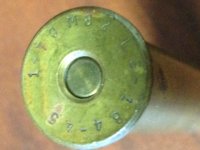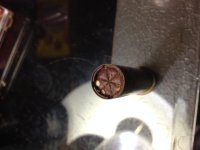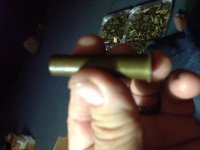You are using an out of date browser. It may not display this or other websites correctly.
You should upgrade or use an alternative browser.
You should upgrade or use an alternative browser.
Case Identification
- Thread starter eluce
- Start date
Measurements of the case (length, diameter, rim size, etc) would be a tremendous help.
Without them, there is really no way to be sure.
As a guess, based on the pics, it could be a .45-70 "blank", or Line Throwing Cartridge. Or it could be a shot cartridge that someone made in a .45-70 case.
it is about the right size. Or it could be some other case with close dimensions. Without measurements, you can't be certain just by eye.
I don't recognize the headstamp. Sorry.
Without them, there is really no way to be sure.
As a guess, based on the pics, it could be a .45-70 "blank", or Line Throwing Cartridge. Or it could be a shot cartridge that someone made in a .45-70 case.
it is about the right size. Or it could be some other case with close dimensions. Without measurements, you can't be certain just by eye.
I don't recognize the headstamp. Sorry.
Jim Watson
New member
It might be an artillery ignition cartridge or "primer tube."
Mike Irwin
Staff
That's a live primer cartridge for US heavy artillery using bagged powder charges.
More information here:
http://iaaforum.org/forum3/viewtopic.php?f=8&t=8143&view=next
No more or less dangerous than a blank cartridge.
No nerve gas, no anthrax, no napalm-covered flaming troll midgets.
More information here:
http://iaaforum.org/forum3/viewtopic.php?f=8&t=8143&view=next
No more or less dangerous than a blank cartridge.
No nerve gas, no anthrax, no napalm-covered flaming troll midgets.
tahunua001
New member
those napalm covered flaming troll midgets are no laughing matter. had a aunt's cousin's wife's half sister's uncle get hit with one of those... he didn't come out of that one pretty.
I'm glad to know that round is an artillery igniter and no more harmful than any small arms ammunition. But my comments were not a joke; both those substances have been used in conventional-looking ammunition, as well as such nice things as botulis toxin, PETN, and plain old TNT. Mercury fulminate is usually thought of as an old time primer material, but it has also been loaded into bullets as an impact explosive.
Jim
Jim
bedbugbilly
New member
Now that the controversy is all solved . . .
I have a question for you military fellows . . .
I wasn't in the military and my only experience with artillery is full size Civil War Parrott Rifles and Mortors . . . obviously much different than "modern artillery".
Question - were these primers all of one size regardless of size of artillery piece or were they made in different sizes depending on bore/powder load?
Thanks.
I have a question for you military fellows . . .
I wasn't in the military and my only experience with artillery is full size Civil War Parrott Rifles and Mortors . . . obviously much different than "modern artillery".
Question - were these primers all of one size regardless of size of artillery piece or were they made in different sizes depending on bore/powder load?
Thanks.
There are different sizes and shapes. One I saw (no idea what gun it was for) was about the size of a 12ga shell, with a slight bottleneck.
Lots of different guns from lots of nations over lots of years, different sizes/shapes for different jobs.
We have small pistol, and large rifle magnum primers, same idea still working with really big guns some only firing a couple dozen pounds of powder, other firing a couple hundred pounds each shot.
Lots of different guns from lots of nations over lots of years, different sizes/shapes for different jobs.
We have small pistol, and large rifle magnum primers, same idea still working with really big guns some only firing a couple dozen pounds of powder, other firing a couple hundred pounds each shot.
The Naval Rifles of the Great White Fleet's Armored Cruiser #6 the U.S.S. San Diego used 30-40 blanks for her 8" 40 cal main guns. I don't know about the others. They look like regular star crimped blanks, possibly with a different powder from ceremonial blanks?
Last edited:



